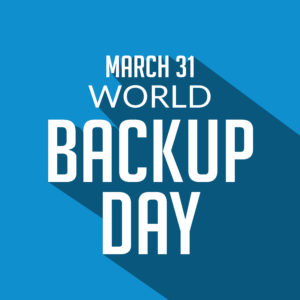
Where’s Your Data Now? Thoughts on World Backup Day

We’ll excuse you if you forgot that today is World Backup Day. You probably have a lot on your plate already. But we’d be remiss if we neglected to mark the occasion and discuss how companies can protect their most important asset: their data.
Every March 31, the world comes together to ponder the miracle of backup and brainstorm ways to ensure our precious data is sufficiently protected. We’re all feeling a bit imperiled due to the global COVID-19 pandemic, so perhaps this a fitting time to reflect on the various ways we put data at risk – and come up with ways to make it better.
“The fact that World Backup Day falls on March 31 is no coincidence,” says Amanda Regnerus, EVP of Product and Services at US Signal. “The next day may be about laughs and pranks, but the potential loss of data is no joke.”
With 83% of organizations having experienced a DDoS attack within the last two years and 38% being impacted by a ransomware attack in the last twelve months, it is more important than ever to ensure that your data is backed up and secure, she says.
“DR plans don’t need to be complicated, they just need to be implemented and tested regularly,” Regnerus continues. “Having said that, it is important to take into account some key components when developing a DR plan. These include the ability to roll back backups to previous versions, ensuring that you are able to stay current with data replication needs, and being able to quickly and securely retrieve your data.”
If having one copy of your data is good, then having two copies is even better, says Carl D’Halluin, the CTO of Datadobi.
“We are in trying times,” D’Halluin says. “With incidents of ransomware attacks on vulnerable file storage systems on the rise, organizations have clear directives to back up their file data to avoid disaster and a key part of that process is having a secure third copy of their NAS data in case of an attack on production or disaster recovery systems. This step provides greater security if other means of protection and proper data backups have failed.”
Don’t be fooled by outdated approaches to data protection, which can’t scale to handle today’s NAS volumes, he says. However, with the proper tool, creating a third copy of NAS data, no matter how big or small, can be straightforward. “Putting such an option in place–in a bunker site, behind an air gap, or in the cloud–gives organizations reliable data backup and restore capabilities,” he says.
One of the most overlooked aspects of backups is ensuring the security of the data, according to Neil Stobart, vice president of Global System Engineering at Cloudian.
“With backup data being the key element in data restoration and cyber criminals consequently specifically targeting this data in ransomware attacks, companies need to concentrate on protecting their backups,” Stobart says. “One of the most effective and also easiest strategies to block off attacks aimed at the backup is WORM (write once, read many).”
Because WORM storage makes the data immutable, it’s immune to any malware the attackers might use to encrypt the volume. In the event of a ransomware attack, organizations can simply the data from their backup through a simple recovery process, and move about their business.
Consider how the cloud can factor into your backup and recovery strategies, says Matthew Tyrer, senior manager of solutions marketing for Commvault.
“The ability for cloud to scale up and down supports a much more cost effective disaster recovery strategy,” Tyrer says. “The cloud can also help with regulation as it helps organizations have more visibility and therefore allows them to learn more about the data that they have under management.”
Where is the data that is important to governance and compliance being stored? Do you know what it is? Where it is? How to find it? “Having a cloud-based solution that can easily assist in this will overall reduce your costs and stay compliant because it lets you manage your data smarter,” he adds.
Whether you’re backing up from on-prem to the cloud, from the cloud to another cloud, or from the cloud to on-prem, clouds play a bigger role in the backup equation than ever before. That’s why backup needs to be a critical component of IT security team’s data protection strategy, says SolarWinds Vice President of Security, Tim Brown.
“For this World Backup Day, I encourage tech pros to make sure their backup solutions are 1) running consistently, 2) inclusive of all data located anywhere from on-prem to cloud, 3) scalable to cover endpoints and applications, 4) secure with controlled access to authorized users only, and 5) working efficiently to enable tech pros to respond faster if something goes wrong,” Brown says.
Large enterprises with complex IT environments tend to have the most sophisticated backup environments. These companies can afford to build backup systems that dramatically reduce the odds of losing data. Unfortunately, research indicates that 20% of small and midsize businesses (SMBs) without a backup or recovery strategy, according to Infrascale.
“Each organization is different,” says Infrascale CEO Russel Reeder. “But one thing all businesses have in common is a desire to eradicate downtime and data loss. Organizations can and should protect their data, and their businesses as a whole, by enabling comprehensive data protection with modern backup and disaster recovery solutions and strategies.”
Related Items:
Crafting a Hybrid Cloud Backup Strategy
Tape, It’s Not Just for Backup Anymore
































